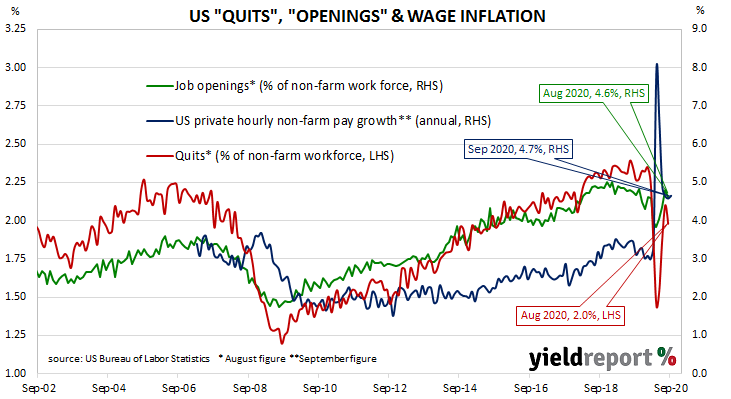Summary: US quit rate falls after rising for three months; job openings, total separations also down; twice as many jobless as openings.
The number of US employees who quit their jobs as a percentage of total employment increased slowly but steadily after the GFC. It peaked in March 2019 and then tracked sideways until virus containment measures were introduced in March 2020. Quit rates plummeted as alternative employment opportunities rapidly dried up. A rapid recovery then took place over the next few months.
Figures released as part of the most recent JOLTS report show the quit rate fell after rising for the previous three months. 2.0% of the non-farm workforce left their jobs voluntarily in August, a decline from July’s comparable figure of 2.1%. The largest source of fewer quits arose from the “Other services” and construction sectors while the “Finance and insurance” sector experienced a greater number of quits. Overall, the total number of quits for the month decreased from July’s revised figure of 2.932 million to 2.793 million.

April’s non-farm payroll report indicated average hourly pay had spiked, possibly the result of fewer lower-paid jobs relative to higher paying ones. Subsequent months’ figures then saw falls in average hourly pay, with a corresponding fall in the annual growth rate from 8.0% in April to 4.7% in September.
Total vacancies at the end of August decreased by 204,000, or 3.0%, from July’s revised figure of 6.697 million to 6.493 million, driven by falls in the “Health care and social assistance”, construction and “Retail trade” sectors. Increased openings in the “State and local government” and, to a lesser extent, the “Accommodation and food services” sectors provided some offsetting effects. Overall, 11 out of 18 sectors experienced fewer job openings than in the previous month.
Total separations during the same period decreased by 394,000 from July’s revised figure of 4.988 million to 4.594 million. The change was led by the “Professional and business services” sector, where there were 102,000 fewer separations than in July. Separations increased in 6 of 18 sectors but they were all quite small individually.
“There are currently twice as many unemployed compared to jobs available,” noted ANZ senior economist Catherine Birch.

